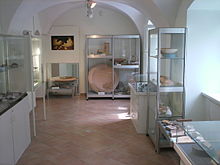Wallsee-Sindelburg Roman Museum
The Wallsee-Sindelburg Roman Museum is a museum in Wallsee-Sindelburg in Lower Austria . It is dedicated to the history as well as the exhibition and presentation of the finds from the Wallsee cohort fort discovered in 1966 and its civilian settlement ( vicus ).
museum
The basis of the collection are finds that have been collected since 1889 by Carl Samwer, archivist for the Duke of Saxe-Coburg-Gotha (e.g. over 100 coins, ceramics and 9 picture stones that are kept in the castle) and by the elementary school director Elmar Tscholl. The latter made a special contribution to the discovery of the fort.
The museum, which was opened in 1997 and looked after by an association, is housed in the premises of the so-called "Salt House", which is located at the northeast exit of the market square, opposite the entrance to the park of Wallsee Castle. Only Roman finds from Wallsee are presented in its exhibition rooms. The museum can be visited from May to September, every Wednesday from 6 p.m. to 7 p.m. or by appointment (see web link).
structure
The museum's exhibition area is divided into a total of four showrooms.
- Room 1 is dedicated to the history of the Noric Danube Limes .

- Room 2 presents the Roman military system on the Limes, in particular the mid-imperial occupation troops of the fort, the cohors I Aelia Brittonum (1st Aelian cohort of the Britons ) set up under Hadrian whose presence in Wallsee was mainly due to brick stamp finds ( C [ohors] PR [ima] AU BR [ittonum]) is occupied. Numerous remains of bricks (especially roof, slab and hypocaust tiles) also testify to the craftsmanship of the soldiers.
- In room 3, the visitor gets an insight into pagan and Christian beliefs, religions and the cult of the dead of soldiers and civilians at the Limes in Norway. Well-preserved fragments of grave structures ( Columbarium ) show scenes from mythology and economic life of the Romans. A significant piece of the collection is a roof tile with the head of a fish carved into it; this find is considered an early testimony to the burgeoning Christianity in northern Noricum .
- Room 4 is about Roman commercial and civil life. In addition to terra sigillata and local pottery, tools, jewelry and fittings can be seen. The finds from a Roman dairy and cheese factory occupy a special position among the exhibits. In its remains, by far the largest known Roman clay bowls (so-called " milk satellites ", diameter approx. 1 m) were recovered.
exhibition
Architectural monuments and excavations
Since the medieval core of Wallsee lies within the camp area, nothing can be seen of the fort today above ground. However, you can use the signs for the Roman tour and the green floor markings on the market square to clearly grasp its location and extent. A piece of the foundation wall of the late antique remaining fort (SO corner of the fort) has been made visible at the kindergarten. Some grave reliefs can be viewed in the castle by prior arrangement.
swell
- Herwig Friesinger, Fritz Krinzinger (Hrsg.): The Roman Limes in Austria, guide to the archaeological monuments. Publishing house of the Austrian Academy of Sciences, Vienna 1997, ISBN 3-7001-2618-2 , p. 201.
- Lower Austria cultural reports / history, therein: Heimo Cerny: Römisches Wallsee-Adiuvense. Pp. 20-21.
- Folder: Roman Museum Wallsee-Sindelburg at the beginning of the Lower Austrian Danube Limes and the Eisenstrasse.
Web links
- More information about the Roman Museum Wallsee at limes-oesterreich.at
- Report from the daily newspaper Kurier about the planned new museum building
Coordinates: 48 ° 19 '59.8 " N , 16 ° 3' 25.6" E







